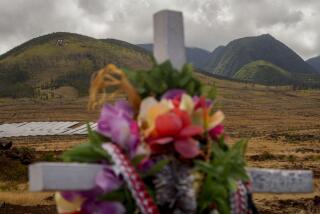Hawaiians Want Their Land Returned : Sovereignty movement grows, pressing for ‘nation within a nation’ status.
HONOLULU — “ E molia aku i na kolea ‘aihue ea ... “ “Sacrifice the foreigners who have stolen our sovereignty . . . Return to us the land . . .”
Her chant to Gods and ancestors concluded, Dr. Lilikala Kame’eleihiwa, director of Hawaiian studies at the University of Hawaii, plunges into a vivid account to nine attentive judges of the adverse impact of the United States on her nation.
Over on the north side of Oahu, others are organizing demonstrations against a freeway that is cutting through ancient burial and temple sites.
Go to the other islands in the archipelago and you’ll find similar activism. On Hawaii--Big Island--there’s a struggle against a geothermal project that threatens to destroy a rain forest. On Kauai there are actions against the use of public lands for missile tests, part of a death twitch of the “Star Wars” program.
There are scores of other such political struggles under way. In back of them lies something that has been growing steadily in force for at least 15 years: the reassertion of Hawaiian sovereign rights.
Earlier this year the sovereignty movement, known as Ka Lahui Hawai’i (the Hawaiian People) organized the largest gathering of native Hawaiians in the past 100 years.
Fifteen thousand people mustered in front of the Iolani Palace on Jan. 17, centennial of the overthrow of Queen Liliuokalani by white settlers backed by the U.S. Navy. The largest of the groups agitating for political and sovereign rights, Ka Lahui Hawai’i, has about 18,000 members, a constitution, a concise program and a respected presence in international gatherings of indigenous peoples.
Ka Lahui is a nationalist movement but it is not seeking Hawaiian independence. As its head, Mililani Trask, matter-of-factly explains, they are realists, and they reject violence. Their goal is the status of “nation within a nation,” with a land base made up of about 1.5 million acres, land formally held in trust for native Hawaiians or deeded to them.
By a fragrant mix of chicanery, legal hocus-pocus and political corruption, this land--some of it of immense value--has never been distributed to its rightful heirs.
Thus, unlike other indigenous groups, the native Hawaiians have no land base. As “wards of the state” they have also faced near-impossible odds in trying to get legal standing in federal or state courts to sue to recover their lands.
When Trask and her colleagues finally extorted a modicum of such standing two years ago, a new state law decreed that no successful Hawaiian litigant could ever receive land as a consequence of a court victory.
Over the past two weeks, nine judges mustered to a tribunal from across the world have been listening to an indictment of the United States for its abuse of Hawaiian rights. The charges range from abetting the white settler coup d’etat of 1893, through formal U.S. annexation in 1898, imposition of statehood in 1959, appropriation of Hawaiian land and resources, to acts of genocide and ethnocide against the indigenous people.
There was a chair reserved for the accused, but no one from the U.S. government showed up. The “judges” were in fact lawyers, plus one theologian and two writers, one Japanese and one American Indian--an accurate rendition of cultural norms in the modern era.
Serving on the tribunal were a couple of eminent white law professors, Richard Falk of Princeton and Milner Ball of the University of Georgia; others included Moana Jackson, a Maori lawyer from New Zealand, and Sharon Venne, a Cree lawyer from Saskatchewan. After hearings on all the major islands, they issued an interim finding that sustained the indictment. The full record of testimony and judicial findings will come in a few months.
The disadvantage of such tribunals is their informal nature. Adverse judgment is not followed by the clang of the prison gate or the thunk of Uncle Sam plunging through the hangman’s trap door. What’s aimed at here is the furnishing of a competent record of what precisely was done to the Hawaiian people, as well as public advertisement of the strength of the sovereignty movement.
Of the latter there is no doubt. A powerful campaign for civil and sovereign rights is under way. The time is ripe for Ka Lahui Hawai’i. Impatient Hawaiians, so long on the margins of society, sleeping in old cars or on the beaches, are already occupying lands. After more than 200 years of horror and a century of annexation, they are no longer prepared to see justice denied or even postponed.










